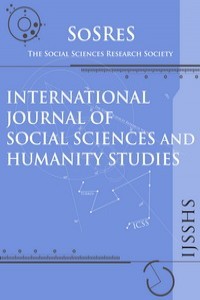AN ECONOMETRIC ANALYSIS OF THE RELATIONSHIPS BETWEEN ECONOMIC GROWTH AND AGRICULTURAL CREDITS FOR PROPOOR GROWTH in TURKEY
AN ECONOMETRIC ANALYSIS OF THE RELATIONSHIPS BETWEEN ECONOMIC GROWTH AND AGRICULTURAL CREDITS FOR PROPOOR GROWTH in TURKEY
The agricultural sector is important for Turkey for many reasons such as high rate of rural population, a large share of employment in the agricultural sector, the sector's contribution to the formation of national income, and production capacity of sector. In recent years, although the share of agriculture sector in GDP and in foreign trade has declined, the share of it in employment is still protected. The agricultural sector is the backbone of the rural economy. Although there is a common view that agriculture is an important sector for an economy, there is no consensus about preference of agricultural growth in reducing poverty as the best remedy. Some researchers advocates that primarily this sector should bear of the importance in reducing poverty because the majority of the poor live in rural areas and are employed in the agricultural sector. Another view is that non-agricultural activities provide capital accumulation and thus more rapid development. Many studies in the literature, suggest that investments in the areas like rural infrastructure, health and education with agricultural development in developing countries are pro-poor. The objective of this study is to examine whether there is a relationship between agricultural growth and economic growth in the long-term and to analyze whether there is a relationship between agricultural credits as an agricultural support and agricultural growth in the long term. In addition, it is aimed to investigate if the agricultural credits is effective on the number of people employed in agriculture. Empirical findings of the study reveals that agricultural credits has a direct effect on agricultural income and employment, on the other hand it also shows that agricultural credits has indirect effect on the agricultural income due to the impact of agricultural credits on agricultural income and the impact of agricultural income on agricultural employment.
Keywords:
Pro-poor growth, agricultural credits agricultural growth,
___
- Akram, Waqar, Zakir Hussain, Hazoor M. Sbir, and Ijas Hussain, (2008), Impact of Agricultural Credit on Growth and Poverty in Pakistan (Time Series Analysis Through Error Correction Model), European Journal of Scientific Research Vol.23, No.2, pp:243-251
- Anthony, Enoma, (2010), “Agricultural Credit and Economic Growth in Nigeria: An Emprical Analysis” Bussiness and Economics Journal, Vol:2010:BEJ-14
- Bezemer, Dirk and Derek Headey, (2008), “Agriculture Development and Urban Bias” World Development Vol.36, No.8, pp:1342-1364.
- Çelik, Nebi, (2000), Tarımda Girdi Kullanımı ve Verimliliğe Etkileri, DPT Uzmanlık Tezi, Yayın No: 2521
- Chabbi, H. Edine and Lassad Lachaal, (2007), “Agricultural Sector and Economic Growth in Tunisia: Evidence from Cointegration and Error Correction Mechanism” MPRA Paper No: 9001
- Datt, Gaurav and Martin Ravallion, (1998), “Why have some Indian States Done Better than Others at Reducing Rural Poverty?” Economica Vol.65, pp:17-38.
- Datt, Gaurav and Martin Ravallion, (2002), “Is Indian’s Economic Growth Leaving the Poor Behind?” Journal of Economic Perspectives Vol.16, pp:89-108. Khan, Naushad et all. (2011), “Review of Past Literature on Agriculture Credit in Rural Area of Pakistan” Sarhad Jornal of Agriculture Vol.27 No.1, pp:103-110
- Katircioglu, Salih (2006), “Causality Between Agriculture and Economic Growth in a Small Nation Under Political Isolation: A Case from North Cyprus”,
- International Journal of Social Economics, Vol.33 No.4, 331 - 343.
- Kimenyi, S.Mwangi, (2002), “Agriculture, Economic Growth and Poverty Reduction” Kenya Institute for Public Policy Research and Analysis (KIPPRA), Occasional Paper No:3
- Matsuyama Kiminori, (1991), “Agricultural Productivity, Comparative Advantage and Economic Growth” NBER Working Paper No: 3606.
- Mundlak,YAir, Domingo Cavallo and Roberto Domenech (1989), ), “Agriculture, Economic Growth in Argentina, 1913-1984” International Food Policy Institute Research Report 76.
- Oecd, (2006), “Promoting Pro-poor Growth: Agriculture” DAC Guidelines and References Series.
- Ravallion, Martin and Gaurav Datt, (1996), “How important to Indian Poor is the Sectoral Composition of Economic Growth?” World Bank Economic Review Vol.10, pp:1-26
- Sabur, Abdul, (2004), “Agricultural Growth, Rural Poverty and Income Inequality in Pakistan: A Time Series Analysis” Department of Agricultural Economics, Faculty of Agricultural Economics & Rural Sociology, University of Agriculture, Faisalabad, Pakistan.
- Suryahadi, Asep, Suryaderma Daniel and Sudarno Sumarto, (2009), “The Effects of Location and Sectoral Components of Economic Growth on Poverty: Evidence from Indonesia” Journal of Development Economics Vol.89, pp:109-117.
- Tanrivermiş, Harun and Mehmet Bülbül, (2007), “The Role of Agriculture in Turkish Economy at the Beginning of the European Union Accession Negotiations” Journal of Applied Sciences Vol.7, No. 4, pp:612-625.
- Thirtle, C. et all. (2003), “The Impact of the Research Led Agricultural Productivity on Poverty Reduction in Africa, Asia and Latin America.” World Development Vol.31, No. 12, pp:1959-1975.
- Tomasz, Suidek, “Do Farm Credits Stimulate Development of Agriculture in Poland?” 12. Congress of European Association of Agricultural Economists, EAAE 2008.
- WORLD BANK, (2008), “Agriculture and Economic Growth” Agriculture for Development in World Development Report 2008.
- Başlangıç: 2009
- Yayıncı: Sosyal Bilimler Araştırmaları Derneği
Sayıdaki Diğer Makaleler
STUDY AND ANALYSIS OF VAT EVASION AND ILLEGAL RECOVERY IN LEBANON
Rana ISMAİL, Faisal NSOULİ, Wafic RİHAN
Hakan TURGUT, İsmail TOKMAK, Cem GÜÇEL
DETERMINANTS OF FORMAL AND INFORMAL SECTOR EMPLOYMENT IN THE URBAN AREAS OF TURKEY
STOCKHOLDING AND FINANCIAL LITERACY IN THE FRENCH POPULATION
Luc ARRONDEL, Majdi DEBBİCH, Frédérique SAVİGNAC
LEADERSHIP AND PROFESSIONALISM AS FUTURE CHALLENGE IN PUBLIC SECTOR UNIVERSITY MANAGEMENT
Dita STEFENHAGENA, Voldemars BARİSS
CHILD ABUSE IN MALAYSIA: LEGAL MEASURES FOR THE PREVENTION OF THE CRIME AND PROTECTION OF THE VICTIM
DIAGNOSTICS OF RUSSIAN CONSUMER MARKET STATE IN TERMS OF DESTRUCTIVE EFFECTS INFLUENCE
